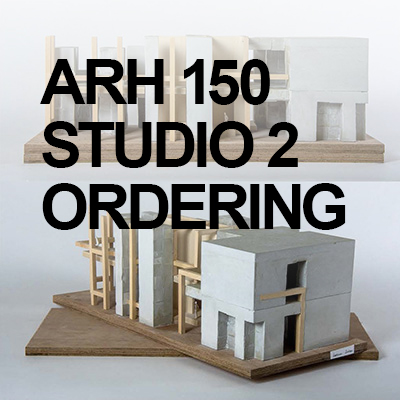
ARH 150 STUDIO 2 SPATIAL ORDERING & FORM
Develop your critical design decision-making abilities through experimentation. You will research and analyze a case study project, identify key spatial ideas, and incorporate these ideas through an iterative process of model-making, diagramming, and drawing for small scale projects.
Prerequisites: ARH 110, ARH 170, ARH 180 (ARH 180 may be taken concurrently)
Software: Rhino, Adobe Creative Cloud
Course Learning Outcomes
- Identify conceptual, spatial, formal, and material orders through critical analysis of canonical precedent buildings
- Demonstrate an understanding of the relationship between materiality, space and form through making
- Articulate and extend conceptual thinking through diagrams
- Clearly communicate design ideas in written, spoken and graphic form
- Construct architectural drawings and models with a high level of craft, precision, and attention to detail
- Use an iterative design process to incorporate feedback and refine proposals
- Develop criteria to generate and evaluate organizing principles
- Develop architectural proposals appropriate for the site context
- Organize efficient floor plans to meet user and program requirements
NAAB CRITERIA
- This course addresses part of NAAB PC 2 Design: How the program instills in students the role of the design process in shaping the built environment and conveys the methods by which design processes integrate multiple factors, in different settings and scales of development, from buildings to cities.
- This course addressses NAAB PC.7 Learning and Teaching Culture: How the program fosters and ensures a positive and respectful environment that encourages optimism, respect, sharing, engagement, and innovation among its faculty, students, administration, and staff
- This course addresses NAAB Shared Values of Design: Architects design better, safer, more equitable, resilient, and sustainable built environments. Design thinking and integrated design solutions are hallmarks of architecture education, the discipline, and the profession
Additional Information
This course is a second-semester undergraduate design studio comprised of a series of projects that provide a solid ground from which students can develop their architectural interests. While emphasizing fundamental skills such as diagramming, hand-drafting, and physical model-making, students will also build their ability to conceptualize, develop, and communicate spatial ideas. Beginning with an in-depth analysis of architectural precedents, students apply their insights to a series of abstract, formal exercises, developing systems of order and design logic that form the basis for their final design project of a hybrid building in San Francisco.
The course fosters design as a medium of speculation, and it challenges students to explore architecture’s potential to generate experience, shelter, accommodate program, and respond to its broader context. Design is approached as an iterative process through which the act of crafting, evaluating, and refining is a core value. This course teaches students to make thoughtful, informed decisions about how to solve design problems while realizing their artistic visions.
Student Project By: Sladek Jaroslav
Student Project By: Amy Velez
